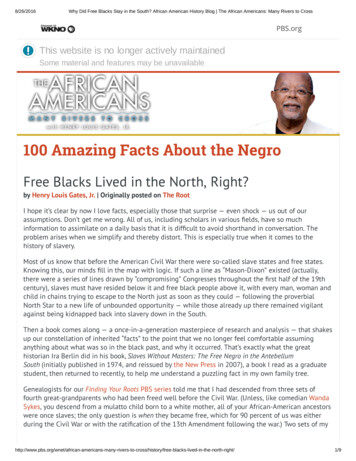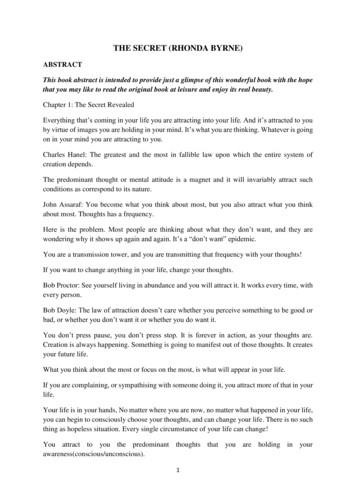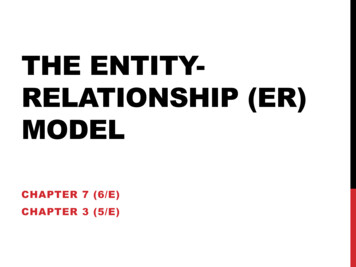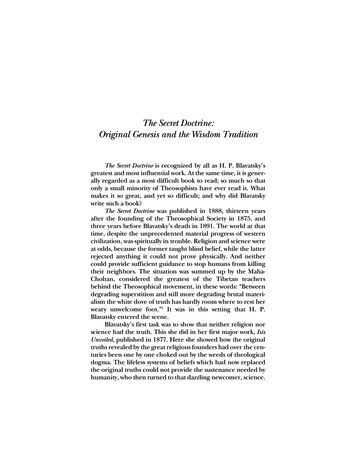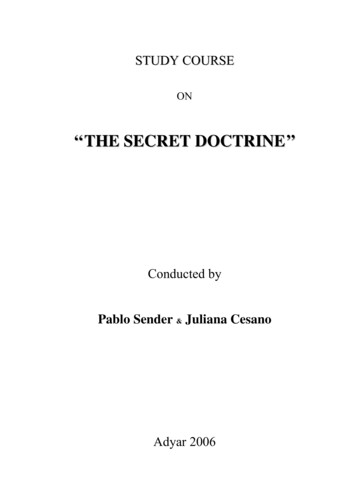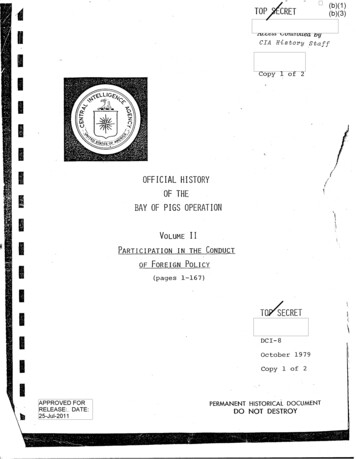
Transcription
The Secret RelationshipBetween Blacks and JewsVolume OneThe Nation of IslamBoston 1991AAARGH Publishing HouseInternet 2006
WHY WE REPUBLISH THIS PRECIOUS BOOKThis book has been published fifteen years ago in the United States, at atime when the Black Movement was reaching a new phase in the century-oldstruggle for freedom. It created a huge scandal and all the resources of the Zionist lobby were directed against this book, to destroy it in order to keep the AfroAmericans under the traditional yoke of submissiveness to the interest of theJewish community, a situation which had become obvious to all in the US.The controversy, the important role played by The Nation of Islam in theliberation struggle of the Black Men, did not spill over in Europe. We broughtback the book from Chicago but failed, at the time, to procure the funding for atranslation and a publication in Europe's languages. The time was not ripe. Theliberation forces were divided and weak. But the craving for freedom was simmering among the oppressed. Slowly, bit by bit, a Black Liberation Movementrose up again. Particularly in France, it has reached a stage where it plays apolitical role. Traditional political forces, and particulalrly, traditional enemiesof freedom are lauching offensives, one after the other, to gain control over thisnew-born potential political giant, while it is still in infancy. We have reached asituation where the book penned by the Research Department of the Nation ofIslam has become an urgent political necessity in the struggle to maintain theindependence of the Freedom Movement. This made us bold enough to put online the original book and decide to translate it. There is no other material possibility to spread the book around in our region. The translation will be put onlineas soon as it becomes available.AAARGH, Oct. 1st, 2006NB : The book still sells. We strongly recommend to our readers to buy the book itself (US 20), if possible, and if they can afford the relatively high costs of the mailing, byordering it from the publisher at:http://store.finalcall.com/misc/page2.htm
IVA Note on SourcesThe information contained herein has been compiled primarily from Jewish historicalliterature. Every effort has been made to present evidence from the most respected of the Jewish authorities and whose works appear in established historical journals or are published byauthoritative Jewish publishing houses. A substantial body of evidence that supports the findings herein was excluded by the editors and deemed to be from sources considered antiSemitic and/or anti-Jewish.Footnote AbbreviationsThe following abbreviations will be substituted for often cited reference material.AJA - American Jewish Archives (Cincinnati: Hebrew Union College)AJHQ - American Jewish Historical Quarterly changed from PAJHS - Publications of theAmerican Jewish Historical Society at vol. 51, September, 1961.EAJA - Herbert I. Bloom, The Economic Activities of the Jews of Amsterdam in the Seventeenth and Eighteenth Centuries (Port Washington, New York/London: Kennikat Press,1937)EHJ - Salo W. Baron, Arcadius Kahan, Nachum Gross, ed., Economic History of the Jews(New York: Schocken Books, 1975)EJ - Encyclopaedia Judaica (Jerusalem: Keter Publishing House, Ltd., 1971)Emmanuel HJNA - Isaac S., and Susan A. Emmanuel, History of the Jews of the NetherlandAntilles (Cincinnati: American Jewish Archives, 1973)Karp, JEA(1,2,3) - Abraham J. Karp, ed., The Jewish Experience in America: Selected Studiesfrom the Publications of the American Jewish Historical Society (Waltham, Massachusetts, 1969, 3 volumes)MCAJ (1,2,3) - Jacob Rader Marcus, The Colonial American Jew: 1492-1776 (Detroit:Wayne State University Press, 1970, 3 volumes)JRM/Docs. - Jacob Rader Marcus, American Jewry: Documents of the Eighteenth Century(Cincinnati: Hebrew College Union Press, 1959)MEAJ(1,2) - Jacob Rader Marcus, Early American Jewry (Philadelphia: Jewish PublicationSociety of America, 1951, 2 volumes)JRM/Essays - Jacob Rader Marcus, ed., Essays in American Jewish History (American JewishArchives, KTAV Publishing House, Inc., 1975)JRM/Memoirs(1,2,3) - Jacob Rader Marcus, Memoirs of American Jews 1775-1865 (NewYork: KTAV Publishing House, Inc., 1974, 3 volumes)MUSJ(1, 2) - Jacob Rader Marcus, United States Jewry, 1776-1985 (Detroit: Wayne StateUniversity Press, 1989)PAJHS - Publications of the American Jewish Historical Society changed to (AJHQ) American Jewish Historical Quarterly, vol. 51, September, 1961.
Table of ContentsIntroductionviiJews and the African Slave Trade 9Columbus, Jews and the Slave Trade 11The Jews and Slavery in Colonial South America and the Caribbean 18Brazil 20The Spanish Inquisition 33Surinam 35Essequebo, Guiana 49Barbados 56Curaçao 64Jamaica 73Martinique 78Nevis 79Saint Dominique 80Saint Eustatius 81Saint Thomas 81Jews and Slavery in Colonial North America 89New York 92Newport, Rhode Island 99Pennsylvania 103Jews and the Red Man 105Jews in the South 120Virginia 124Carolinas 127Georgia 131Jews in the West 137Jews, Slavery and the Civil War 139Jewish Clergy and Black Slavery 143Jews and Abolitionism 147Jews and the Confederacy 157Jews and the Economics of the Civil War 161Reconstruction, Blacks and Jews 169Holocaust 177Census Data of Jews and Black Slaves 182Slaves in Jewish Wills 186Anti-Semitism? 186Jews and the Rape of Black Women 196Slavery in Jewish Law 202Blue Laws 205Jews, Blacks and the Law 207Jews and the Great Nat Turner 211Black Slave Owners and Jews 212Jews of the Black Holocaust 213Selected Bibliography 313Index 319
[vi]Editor's NoteThis study is structured as a presentation of historical evidence regarding the relationship of one people with another. The facts, as established by highly respected scholars of theJewish community, are here exposed and linked by as sparse a narrative as is journalisticallypermitted for review by those interested in the subject. It is not the mission of this study tointerpret the data to an extent greater than is required to present these facts clearly. The facts,we believe, speak for themselves. Statements will be presented and then verified by referenceswhich are fully cited in the footnotes. Some statements may seem redundant only because wehave made every attempt to include the words of every Jewish scholar who has commented onthe subject at hand. We have made every effort to be fair and just in the presentation of thisdata and hereby invite all analysis to the contrary.The terms buy, own and sell, and variations thereof, in connection with the commerce inBlack people, will be used with reservation and primarily for convenience of the reader. In noway should the reader infer sanction of these activities, which are wholly illegal and immoralcrimes against humanity, by the use of the terminology of legitimate commercial transactions.Also, the term slave refers to the African men, women and children who were forcibly entrapped in dehumanizing conditions for the profit of others. We do not accept such a term asdescriptive of their character or nature, only of their circumstance.And finally, the subject at hand is a controversial one and should be approached withgreat sensitivity. Those who would use this material as a basis for the violation of the humanrights of another are abusing the knowledge herein. The wise will benefit to see this as anopportunity to develop a more equitable relationship between the families of man.
[vii]IntroductionThroughout history Jews have faced charges of economic exploitation of Gentile communities around the world. Indeed, no single group of people have faced blanket expulsion inso many places around the world as frequently as have the Jews. The pattern and the chargesare familiar: monopolization, usury, "sharp practices," selling "cheap" goods, frequent bankruptcies, etc. All such claims seem to preface the expulsion orders and are vigorously deniedboth by those charged and by the Jewish writers of history.But this is not the only charge that is made against Jews. Jews have been conclusivelylinked to the greatest criminal endeavor ever undertaken against an entire race of people - acrime against humanity - the Black African Holocaust. They were participants the entrapmentand forcible exportation of millions of Black African citizens into the wretched and inhumanlife of bondage for the financial benefit of Jews. The effects of this unspeakable tragedy arestill being felt among the peoples of the world at this very hour.Deep within the recesses of the Jewish historical record is the irrefutable evidence thatthe most prominent of the Jewish pilgrim fathers used kidnapped Black Africans disproportionately more than any other ethnic or religious group in New World history and participatedin every aspect of the international slave trade. The immense wealth of Jews, as with most ofthe White colonial fathers, was acquired by the brutal subjugation of Black Africans purely onthe basis of skin color - a concept unfamiliar to Moses. Now, compiled for the first time, theJewish sources reveal the extent of their complicity in Black slavery in the most graphic ofterms.[viii]Until now, the facts herein were known only to a few. Most have always assumed thatthe relationship between Blacks and Jews has been mutually supportive, friendly and fruitful two suffering people bonding to overcome hatred and bigotry to achieve success. But historytells an altogether different story. This report will focus on the hidden history of Blacks andJews from the Jewish historical record. Rabbi Henry Cohen, author of the book, Justice justice, makes a telling point:[T]he parallels between the Nazi terror and the American slave trade are more startling than we mayrealize. When Negroes were brought from the heart of Africa to the American South, one-third diedenroute to the African coast and one-third died in the suffocating prisons on board ship. Once here,families were purposely broken up; husbands, wives, and children forced to go their separate ways.Must we be reminded of the death toll in the suffocating boxcars bound for Auschwitz or of thetearing of children from their mothers' arms.'- 1Furthermore, in Roberta Strauss Feuerlicht's, The Fate of the Jews: A People Torn Between Israeli Power and Jewish Ethics, she confronts the reality of her people's western development:[W]hether so many [Southern] Jews would have achieved so high a level of social, political, economic and intellectual status and recognition, without the presence of the lowly and degraded slave,is indeed dubious. How ironic that the distinctions bestowed upon [Jewish] men like Judah P. Ben-1Rabbi Henry Cohen, Justice, justice: A Jewish View of the Black Revolution (New York: Union of AmericanHebrew Congregations, 1968), p. 48.
jamin were in some measure dependent upon the sufferings of the Negro slaves they bought andsold with such equanimity.2It is a relationship that needs further analysis - one that is not fully known. Hidden andmisunderstood, it is indeed time to reopen the files to review and reconsider, The Secret Relationship Between Blacks and Jews.2Roberta Strauss Feuerlicht, The Fate of the Jews: A People Torn Between Israeli Power and Jewish Ethics(New York: Times Books, 1983), pp. 187-88 note 5.
[9]Jews and the African Slave TradeThroughout the history of the practice, Jews have been involved in the purchase andsale of human beings. This fact is confirmed by their own scholars and historians. In his book,A History of the Jews, Solomon Grayzel states that "Jews were among the most importantslave dealers" in European society. 3 Lady Magnus writes that in the Middle Ages, "The principal purchasers of slaves were found among the Jews [T]hey seemed to be always andeverywhere at hand to buy, and to have the means equally ready to pay."4 Henry L. Feingoldstated that "Jews who were frequently found at the heart of commerce could not have failed tocontribute a proportionate share to the [slave] trade directly or indirectly. In 1460, when Jewswere the masters of the nautical sciences in Portugal, that nation was importing 700-800slaves yearly."5The success of these medieval merchants was enhanced by their supreme linguisticabilities. They spoke Arabic, Persian, Roman, Frankish, Spanish and Slavonic and "displayeda business acumen far in advance of the times."6[10]The Jews' participation in the slave trade, particularl7y their trafficking in non-Jewishslaves, incited the moral indignation of Europe's Gentile population. The Europeans reactedby taxing the Jews and some were expelled from their host countries for this activity.8 The3Solomon Grayzel, A History of the Jew: From Babylonian Exile to the End of World II (Philadelphia: JewishPublication Society of America, 1948), p. 312.4Lady Magnus, Outlines of Jewish History, revised by M. Friedlander (Philadelphia: Jewish Publication Societyof America, 1890), p. 107; Jewish Encyclopaedia (New York and London: Funk and Wagnalls Company, 1905 1916), vol. 11, p. 402: "At the time of Pope Gregory the Great (590-604) Jews had become the chief traders inthis class of traffic."5Henry L. Feingold, Zion in America: The Jewish Experience from Colonial Times to the Present (New York:Twayne Publishing, Inc., 1974), pp. 42-3.6Marcus Arkin, author of Aspects of Jewish Economic History (Philadelphia: Jewish Publication Society ofAmerica, 1975), pp. 44-5, reveals that in some European provinces, Jewish traders "appear to have held almost amonopoly of international commerce - so much so that the words 'Judaeus' and 'mercator' appear as synonyms inCarolingian documents." See S. D. Goitein, Jewish Letters of Medieval Traders (New Jersey: Princeton University Press, 1973), pp. 6, 16, 17, 18. Also, Magnus, p. 152, confirms the same. Notice the juxtaposition of the firsttwo sentences of the Magnus passage:They accepted the state of things, and so long as they were let alone, commerce, too, became in Jewish hands adignified, a useful, and an honourable calling. They dealt in slaves, as was the necessity of the time, and theseslaves were the better off for having Jewish masters; their trading fleets sailed on the Mediterranean, and theirready-tongued travellers brought the products of the East to the markets of the West. But gradually all this sort ofcommerce became impossible Then, by force of feeling as well as by law, the slave trade was put down.The Universal Jewish Encyclopaedia, vol. 9, p. 565, states that, for the same reason, the Jews were "especiallyadapted" to the slave trade.78EJ, vol. 14, pp. 1660-64; EHJ, pp. 271-72; According to Magnus (p. 106), however, "Selling people into slavery has a dreadful sound, but in those days it was not quite so dreadful a thing, nor even so avoidable a one, as itwould be in these. Great tracts of cultivated land were constantly being laid waste; what was to be done with thevanquished dwellers thereon?" S. D. Goitein, A Mediterranean Society, The Jewish Communities of the ArabWorld as Portrayed in the Documents of the Cairo Geniza (Berkeley: University of California Press, 1967), vol.1, p. 147, reasons similarly.
The Secret Relationship between Blacks and Jews11expulsion of Jews by European governments was not unusual, with most of the complaintscentered around economic exploitation, monopolizing, or "sharp practice." By 1500, with theexception of certain parts of Italy, Western Europe had closed its doors to Jewish people.9 Thefollowing listing is a partial record of the countries and dates of the Jew's expulsion fromvarious European communities.10Mainz, 1012France,1182Upper Bavaria, 1276England, 1290France,1306France,1322Saxony,1349Hungary, 1360Belgium, 1370Slovakia, 1380France,1394Austria, 1420Lyons, 1420Cologne, 1424Mainz, 1438Augsburg, 1439Upper Bavaria, 1442Netherlands, 1444Brandenburg, 1446Mainz, 1462Mainz, 1483Warsaw, 1483Spain, 1492Italy, 1492Lithuania, 1495Portugal, 1496Naples, 1496Navarre, 1498Nuremberg, 1498Brandenburg, 1510Prussia, 1510Genoa, 1515Naples, 1533Italy, 1540Naples, 1541Prague,1541Genoa, 1550Bavaria, 1551Prague,1557Papal States, 1569Hungary, 1582Hamburg, 1649Vienna,1669Slovakia, 1744Bohemia/Moravia, 1744Moscow, 1891Over the next centuries the centers of Jewish development moved into the WesternHemisphere where land and commercial [11] opportunities provided the incentives for immigration. The open and ungoverned territory and the docile and vulnerable native populationoffered an irresistible attraction to the "maligned race”. They acquired great wealth in theirCaribbean and South American enterprises and eventually moved into the American Northwhich became the economic focal point. It started with the forced expulsion of the Jews fromthe Spanish empire and with the early explorer and "discoverer" of America, Christopher Columbus.Columbus, Jews and the Slave Trade“Not jewels, but Jews, were the real financial basis of the first expedition of Columbus.”11On August 2, 1492, more than 300,000 Jews were expelled from Spain,12 ending theirfive century involvement in the Black hostage trade in that region. In fact, the Spanish Jewsamassed large fortunes dealing in Christian slaves and became quite prominent within Spain'shierarchy.13 They had obtained the most important offices and positions of trust in the cabinets9Yosef Hayim Yerushalmi, "Between Amsterdam and New Amsterdam: The Place of Curaçao and the Caribbean in Early Modern Jewish History," PAIHS, vol. 72 (1982-83), p. 173; Lee Anne Durham Seminario, TheHistory of the Blacks, The Jews and the Moors in Spain (Madrid, 1975), pp. 40-42.10Richard Siegel and Carl Rheins, editors, The Jewish Almanac (New York: Bantam Books, Inc., 1980), pp.127-29.411George Cohen, The Jew in the Making of America (Boston: Knights of Columbus, Stratford Company, 1924),p. 33.12Seymour B. Liebman, The Jews in New Spain: Faith, Flame, and the Inquisition (Coral Gables, Florida: University of Miami Press, 1970), p. 32: The actual number is in dispute. Some authorities have said that 160,000families were expelled, while others have said 800,000 individuals; few have estimated over one million.13Harry L. Golden and Martin Rywell, Jews in American History: Their Contribution to the United States ofAmerica (Charlotte: Henry Lewis Martin Co., 1950), p. 5; Feuerlicht, p. 39: "The golden age of Jewry in Spain
12The Secret Relationship between Blacks and Jewsand counting houses of rulers and had maintained great influence over the regional trade causing many to believe that the Jews exercised an unhealthy domination over the economy of theregion.14 The rulers were convinced enough to order all Jews to either convert to Christ orleave Spain.The Marranos: The Secret JewsThe Marranos were those compulsorily converted Jews and their descendants whooutwardly became Christians but secretly continued to meet in the synagogue, celebrated feastdays and observed the Jewish Sabbath. The name marrano may be derived [12] from the oldCastilian marrano (swine) or perhaps from the Arabic mahran (forbidden). In 1350, Spainbegan a series of conversion drives to convert all Jews in Spain to Christianity (See the section entitled, "The Spanish Inquisition"), and in unprecedented numbers, and with little resistance, the Jews converted.15 This rush to mass conversion, an event, unparalleled in Jewishhistory, is perhaps best summed up by Cecil Roth: "It was not difficult for insincere, temporizing Jews to become insincere temporizing Christians16"The "Marranos," also called conversos (the converted), or nefiti (the neophytes), or"New Christians," were simply charged with not being Catholic. The same applied to theMuslims, who were expelled in like manner and in greater numbers than the Jews.17 Somefifty thousand Jews chose to convert rather than leave their land and their riches.18Contrary to popular notions, those who left were not refugees searching for religiousfreedom, but entrepreneurs looking for economic opportunities. When they fled, they broughtfew Torah scrolls and even fewer copies of the Jewish holy book Talmud with them. Whenasked what he thought most Marranos knew of Judaism after their flight from Spain and Portugal, Roth answered in one word - "Nothing."19The majority fled south and eastward to North Africa and to centers like Salonika,Constantinople, Aleppo and Damascus;20 while others sought and found refuge in the Netherlands where they “established synagogues, schools, cemeteries and a high level of wealth andculture."21 Most escaped "with considerable sums of money."22 Though scattered throughoutthe globe by political, [13] economic and religious circumstances, they would reunite later inan unholy coalition of kidnappers and slave makers.owed some of its wealth to an international network of Jewish slave traders. Bohemian Jews purchased Slavonians and sold to Spanish Jews for resale to the Moors." Also, Jewish Encyclopaedia, vol. 11, p. 402.14M. Kayserling, Christopher Columbus and the Participation of the Jews in the Spanish and Portuguese Discoveries(New York: Hermon Press, 1894), pp. 28, 29, 30, 31, 83.15Max I. Dimont, The Jews In America, The Roots, History, and Destiny of American Jews (New York: Simonand Schuster, 1978), p. 23.16Dimont, p. 24.17Dimont, p. 27.18Dimont, p. 27; Liebman, The Jews in New Spain, p. 32: Father Mariana, a Jesuit, stated: "Many persons [condemned] the resolution adopted by Ferdinand in expelling so profitable and opulent a people, acquainted withevery mode of collecting wealth."19Dimont, p. 28.20Simeon J. Maslin, "1732 and 1982 in Curaçao,", AJHQ, vol. 72 (December, 1982), p. 158; According to LeeAnne Durham Seminario, The History of the Blacks, the Jews and the Moors in Spain (Madrid, 1975), p. 17,Jews were familiar with North Africa:There are some Catalonian and Majorcan maps of the fourteenth century, drawn from the knowledge gleanedfrom Jewish merchants who could travel with relative freedom in North Africa, and showing, with surprisingaccuracy, the routes from the Mediterranean to the land of the Negroes in Guinea and the western Sudan21Maslin, p. 160.22Dr. M. Kayserling, "The Colonization of America by the Jews," PAJHS, vol. 2, (1894), p. 75.
The Secret Relationship between Blacks and Jews13The day after the Spanish expulsion, Christopher Columbus, whose actual name wasCristobol Colon, took a group of Jewish refugees with him to the New World.23 QueenIsabella signed the expulsion decree and Columbus' voyage order the very same day. But itwas not the queen or the king who funded the voyage. George Cohen, among many Jewishhistorians, proclaims that wealthy Jews financed the expeditions of Columbus, and adds thatthe story of Isabella's jewels "is not founded on facts," but rather it was an invention "intendedto glorify the Queen.”24Three Marranos, Luis de Santagel (or Santangelo),25 a wealthy merchant, Gabriel Sanchez,26 the royal treasurer and his assistant, Juan Cabrero, influenced Queen Isabella to helpthem finance the voyage. Cabrero and Santagel invested 17,000 ducats, which would be wellover 100,000 today.27 Alfonso de la Caballeria and Diego de Deza also provided funds;Abraham Ben Samuel Zacuto provided astronomy and navigation equipment and Isaac Abravanel also assisted. Six prominent Jews accompanied Columbus including Mastre Bernal, aphysician; Marco, a surgeon; Roderigo Sanchez, an [14] inspector; Luis de Torres, an interpreter; and sailors Alfonso de la Calle, 28 and Roderigo de Triana, who is claimed to be "thefirst white man ever to see the new world."29 Torres settled in Cuba and has been credited withintroducing tobacco to Europe from his vast tobacco plantations.3023Max J. Kohler, "Luis De Santangel and Columbus," PAJHS, vol. 10 (1902), p. 162: Columbus himself, in hisjournal, calls attention to the "coincidence" of his first voyage of discovery with the expulsion of the Jews fromSpain, in the following passage: "So, after having expelled the Jews from your dominions, your Highness, in thesame month of January, ordered me to proceed with a sufficient armament, to the said regions of India." Forfurther clarification see Kayserling, Christopher Columbus, p. 85 and p. 85 note.24G. Cohen, p. 37; Kayserling, Christopher Columbus, p. 74, states the same: "This story has recently been relegated to the realm of fable."25Cecil Roth, History of the Marranos (Philadelphia: Jewish Publication Society of America, 1932), pp. 272-73:"The first royal grant to export grain and horses to America was made in favor of Luis de Santangel, who maythus be reckoned the founder of two of the greatest American industries." Kohler, "Columbus,"p. 159: "In EmilioCastelar's 'Life of Columbus,' Century Magazine, vol. 44 (July, 1892), p. 364, an interesting passage concerningColumbus' indebtedness to the Jews reads as follows: "It is a historical fact that one day Ferdinand V, on his wayfrom Aragon to Castile, and needing some ready cash, as often happened, owing to the impoverishment of thosekingdoms, halted his horse at the door of Santangelo's house in Calatayud, and, dismounti ng, entered and obtained a considerable sum from the latter's inexhaustible private coffers." Also, Kayserling, Christopher Columbus, shows that this same Luis de Santangel, who was then chancellor of the royal household and comptrollergeneral of Aragon, personally advanced nearly all this money (pp. 55-79). He says (p. 75): “At that time "neitherFerdinand nor Isabella, had at their disposal enough money to equip a fleet." See Kohler, "Columbus," p. 160.26Roth, Marranos, p. 272: "Gabriel Sanchez, the High Treasurer of Aragon, who was another of the explorer'smost fervent patrons, was of full Jewish blood, being a son of a converso couple."27Two hundred years later a fully equipped sailing vessel might have cost 30,000.28Roth, Marranos, p. 272-73: "Mestre Bernal, who had been reconciled in 1490 for Judaizing."; "Rodrigo Sanches, a relative of the High Treasurer, joined the party as Superintendent at the personal request of the Queen.";Luis de Torres, the interpreter, was, according to Golden and Rywell, the first European to set foot in the newland. Alonso de la Calle, whose very name denoted that he was born in the Jewish quarter."29According to Golden and Rywell, p. 9: "It was two o'clock in the morning when he shouted 'Land, Land.' Thesails were shortened and at daybreak Friday, October 12,1492, a new world was before them." Columbusclaimed that it was he who first sighted land in order to claim the royal gratuity of ten thousand maravedis and asilk waistecoat promised to the one who made the first sighting. See Kayserling, Christopher Columbus, pp. 91,110.30Levitan, p. 4; Golden and Rywell, p. 9, claim that Torres "acquired great tracts of land from the Indians." Afamily member, Antonio de Torres, later commanded twelve of Columbus' fleet (Golden and Rywell, p. 7); Israel Abrahams, Jewish Life in the Middle Ages (New York: Atheneum, 1969), p. 138: "Tobacco, so far as its usein Europe is concerned, was also discovered by a Jew, Luis de Torres, a companion of Columbus. The Church,as is well known, raised many objections to the use of tobacco, and King James I's pedantic treatise only voicedgeneral prejudice. Jewish Rabbis, on the other hand, hailed the use of tobacco as an aid to sobriety." Abrahams,p. 139, "It is worth noting that Jews early took to the trade in tobacco, a trade which they almost monopolize in
14The Secret Relationship between Blacks and JewsCecil Roth's History of the Marranos:The connection between the Jews and the discovery of America was not, however, merely a question of fortuitous coincidence. The epoch-making expedition of 1492 was as a matter of fact verylargely a Jewish, or rather a Marrano, enterprise.31Columbus, the Jew?A few scholars, including Roth, present strong evidence that Columbus was himself aJew. He hid his Jewishness, they say, because "no Spanish Jew could ever have expected aidfrom the king and queen of Spain, so the explorer claimed to be an Italian Catholic."32 TinaLevitan, author of Jews in American Life, found the first reference to Columbus' Jewishnessin print in a diplomatic document dated fifty-eight years after the discoverer's death. TheFrench ambassador to Spain, she reveals, refers to "Columbus the [15] Jew."33 Furthermoreshe states:From him we learn that Cristobal Colon (who never called himself Christopher Columbus and neverspoke or wrote Italian) was the son of Susanna Fontanarossa [also spelled Fonterosal and DomingoColon of Pontevedra, Spain, where those bearing such surnames were Jews, some of whom hadbeen brought before the Spanish Inquisition . Letters written by him to strangers have the customary X at the top to indicate the faith of the writer, but of the thirteen letters written to his son onlyone bears an X, and that letter was meant to be shown to the King of Spain. The others have in theplace of the X a sign that looks like the Hebrew characters B and H, initials used by religious Jewsmeaning in Hebrew, "With the Help of God."34Harry L. Golden and Martin Rywell, authors of Jews in American History: Their Contribution to the United States of America, are quite insistent about the Jewishness of Columbus. They cite where Ferdinand, Columbus' son, writes that his father's "progenitors were ofthe blood royal of Jerusalem."35 In Columbus' words, "for when all is done, David, that mostprudent king was first a shepherd and afterwards chosen King of Jerusalem, and I am a servant of that same Lord who raised him to such a dignity."36 One Jewish author insists that "allexisting portraits of the discoverer gave him a Jewish cast of countenance." Another claimedthat a "certain softheartedness in Columbus is a Jewish trait."37 His lineage also pointed toJewish roots - his mother's maiden name was Suzanna Fonterosa, "daughter of Jacob, granddaughter of Abraham and a Jewess. His father, Domingo Colon, was a map-seller. Did notColumbus write the King of Spai
misunderstood, it is indeed time to reopen the files to review and reconsider, The Secret Rela-tionship Between Blacks and Jews. 2 Roberta Strauss Feuerlicht, The Fate of the Jews: A People Torn Between Israeli Pow

